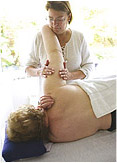 Manual Lymph Drainage aims to redirect fluid from swollen areas to healthy lymphatic vessels, transporting it back to the normal circulatory system . With gentle, light but precise hand movements applied to the skin, the therapists exerts different intensities of pressure to increase the activity of normal lymphatic vessels. This encourages the fluid away from congested areas by bypassing ineffective or injured lymph vessels. The treatment is very gentle and a typical session will involve drainage of the neck, trunk, and the affected extremity (in that order), lasting approximately 40 to 60 minutes. The technique was pioneered by Doctor Emil Vodder in the 1930s for the treatment of chronic sinusitis and other immune disorders.
Manual Lymph Drainage aims to redirect fluid from swollen areas to healthy lymphatic vessels, transporting it back to the normal circulatory system . With gentle, light but precise hand movements applied to the skin, the therapists exerts different intensities of pressure to increase the activity of normal lymphatic vessels. This encourages the fluid away from congested areas by bypassing ineffective or injured lymph vessels. The treatment is very gentle and a typical session will involve drainage of the neck, trunk, and the affected extremity (in that order), lasting approximately 40 to 60 minutes. The technique was pioneered by Doctor Emil Vodder in the 1930s for the treatment of chronic sinusitis and other immune disorders.
According to the International Society of Lymphology, Combined Decongestive Therapy (CDT), also known as Decongestive Lymphatic Therapy (DLT), is the treatment of choice for Lymphoedema . Here CDT is combined with Manual Lymph Drainage (MLD), correct breathing, compression therapy, skin-care and decongestive exercise. Initially, CDT involves frequent visits to a certified therapist with a doctor’s/consultant’s prescription. Once the lymphoedema is reduced, increased patient participation is required for on-going care. The Therapist will teach SLD (Simple Lymph Drainage) and the patient will learn all about the use of elastic compression garments. In this maintenance phase visits to the therapist are less frequent but still essential to ensure the reduction of the oedema . CDT is generally effective . It is not a ‘cure’ in itself but helps to manage the condition and prevents further complications.
